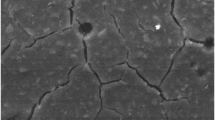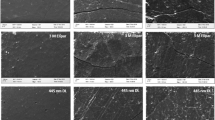Abstract
The objective of this study was to evaluate in vitro light activation of the nano-filled resin composite Vita shade A1 and A3 with a halogen lamp (QTH) and argon ion laser by Knoop microhardness profile. Materials and methods: Specimens of nanofilled composite resin (Z350-3 M-ESPE) Vita shade A1 and A3 were prepared with a single increment inserted in 2.0-mm-thick and 3-mm diameter disc-shaped Teflon mold. The light activation was performed with QTH for 20 s (with an intensity of approximately 1,000 mW/cm2 and 700 mW/cm2) and argon ion laser for 10 s (with a power of 150 mW and 200 mW). Knoop microhardness test was performed after 24 h and 6 months. The specimens were divided into the 16 experimental groups (n = 10), according to the factors under study: photoactivation form, resin shade, and storage time. Knoop microhardness data was analyzed by a factorial ANOVA and Tukey´s tests at the 0.05 level of significance. Results: Argon ion laser was not able to photo-activate the darker shade of the nanofilled resin composite evaluated but when used with 200 mW it can be as effective as QTH to photo-activate the lighter shade with only 50% of the time exposure. After 6 months storage, an increase in the means of Knoop microhardness values were observed. Conclusions: Light-activation significantly influenced the Knoop microhardness values for the darker nanofilled resin composite.

Similar content being viewed by others
References
Yap AU, Soh MS, Han TT, Siow KS (2004) Influence of curing lights and modes on cross-link density of dental composites. Oper Dent 29:410–415
Knezevic A, Zeljezic D, Kopjar N, Tarle Z (2008) Cytotoxicity of composite materials polymerized with LED curing units. Oper Dent 33:23–30
Goldberg M (2008) In vitro and in vivo studies on the toxicity of dental resin components: a review. Clin Oral Investig 12:1–8
Pearson GJ, Longman CM (1989) Water sorption and solubility of resin-based materials following inadequate polymerization by a visible-light curing system. J Oral Rehab 16:57–61
Herbstrith Segundo RM, Gonçalves Mota E, Balbinot CE, Lopes Bondan J, Silva Oshima HM (2008) Influence of storage solution and curing method on a microhybrid composite microhardness. Minerva Stomatol 57:41–46
Leloup G, Holvoet PE, Bebelman S, Devaux J (2002) Raman scattering determination of the depth of cure of light-activated composites: influence of different clinically relevant parameters. J Oral Rehabil 29:510–515
Shortall AC (2005) How source and product shade influence cure depth for a contemporary composite. J Oral Rehabil 32:906–911
Rode KM, Freitas P, Lloret PR, Powell LG, Turbino ML (2009) Microhardness evaluation of a microhybrid composite resin light cured with halogen light, light-emitting diode and argon ion laser. Lasers Med Sci 24:87–92
Jeong TS, Kim YR, Kim JH, Kim HI, Kwon YH (2007) Effects of LEDs on microhardness and temperature rise of dental composite resins. Dent Mater J 26:838–844
Hubbezoğlu I, Bolayir G, Doğan OM, Doğan A, Ozer A, Bek B (2007) Microhardness evaluation of resin composite polymerized by three different light sources. Dent Mater J 26:845–853
Stansbury JW (2000) Curing dental resins and composites by photopolymerization. J Esthet Dent 12:300–308
Calheiros FC, Daronch M, Rueggeberg FA, Braga RR (2008) Influence of irradiant energy on degree of conversion, polymerization rate and shrinkage stress in an experimental resin composite system. Dent Mater 24:1164–1168
Junior RSA, Scherrer SS, Ferracane JL, Bona AD (2008) Microstructural characterization and fracture behavior of a microhybrid and a nanofill composite. Dent Mater 24:1281–1288
Pradhan RD, Melikechi N, Eichmiller F (2002) The effect of irradiation wavelength bandwidth and spot size on the scraping depth and temperature rise in composite exposed to an argon laser or conventional quartz-tungsten-halogen source. Dent Mater 18:221–226
Powell GL, Blankenau RJ (2000) Laser curing of dental materials. Dent Clin North Am 44:923–930
Hinoura K, Miyazaki M, Onose H (1993) Influence of argon laser curing on resin bond strength. Am J Dent 6:69–71
Schneider LFJ, Pfeifer CSC, Consani S, Prahl SA, Ferracane JL (2008) Influence of photoinitiator type on the rate of polymerization, degree of conversion, hardness and yellowing of dental resin composites. Dent Mater 24:1169–1177
Aguiar FH, Lazzari CR, Lima DA, Ambrosano GM, Lovadino JR (2005) Effect of light curing tip distance and resin shade on microhardness of a hybrid resin composite. Braz Oral Res 19:302–306
Gritsch K, Souvannasot S, Schembri C, Farge P, Grosgogeat B (2008) Influence of light energy and power density on the microhardness of two nanohybrid composites. Eur J Oral Sci 116:77–82
Gomes GM, Calixto AL, Santos FA, Gomes OM, D'Alpino PH, Gomes JC (2006) Hardness of a bleaching-shade resin composite polymerized with different light-curing sources. Braz Oral Res 20:337–341
Vlacic J, Meyers IA, Walsh LJ (2007) Laser-activated fluoride treatment of enamel as prevention against erosion. Aust Dent J 52:175–180
Zach L, Coeh G (1965) Pulp response to externally applied heat. Oral Surg Oral Med Oral Pathol 19:515–530
Khosroshahi ME, Atai M, Nourbakhsh MS (2008) Photopolymerization of dental resin as restorative material using an argon laser. Lasers Med Sci 23:399–406
Shimura R, Nikaido T, Yamauti M, Ikeda M, Tagami J (2005) Influence of curing method and storage condition on microhardness of dual-cure resin cements. Dent Mater J 24:70–75
Schulze KA, Marshall SJ, Gansky SA, Marshall GW (2003) Color stability and hardness in dental composites after accelerated aging. Dent Mater 19:612–619
Kanchanavasita W, Anstice HM, Pearson GJ (1998) Long-term surface micro-hardness of resin modified glass-ionomers. J Dent 26:707–712
Mayworm CD, Camargo SS Jr, Bastian FL (2008) Influence of artificial saliva on abrasive wear and microhardness of dental composites filled with nanoparticles. J Dent 36:703–710
Acknowledgements
The authors would like to thank the Special Laboratory of Lasers in Dentistry (LELO) of the University of São Paulo (Brazil) for the use of the argon ion Laser, Dr. Anderson Zanardi de Freitas (and staff) from Laser and Application Center, Energy and Nuclear Research Institute, São Paulo (Brazil) for their assistance and express their gratitude to CNPq (Conselho Nacional de Desenvolvimento Científico e Tecnológico) for financial support for this research and to 3M ESPE for material support.
Disclosure
The authors have no interest in any of the companies or products mentioned in this article.
Author information
Authors and Affiliations
Corresponding author
Rights and permissions
About this article
Cite this article
Cassoni, A., Ferla, J.d.O., Albino, L.G.B. et al. Argon ion laser and halogen lamp activation of a dark and light resin composite: microhardness after long-term storage. Lasers Med Sci 25, 829–834 (2010). https://doi.org/10.1007/s10103-009-0708-x
Received:
Accepted:
Published:
Issue Date:
DOI: https://doi.org/10.1007/s10103-009-0708-x




